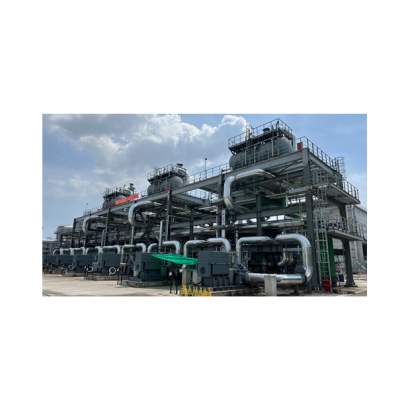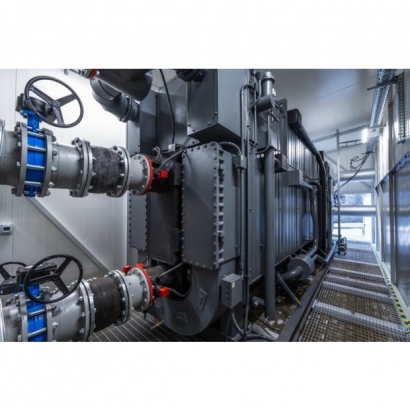All ECO
-
Read More
 CO₂ Capture
CO₂ CaptureCO₂ Capture
CO₂ Capture Solutions
In response to the global trend toward decarbonization, Taiwan Heat Transfer is actively engaged in Scope 2 (CCUS) integrated energy solutions and is also expanding its capabilities in Scope 1 technologies, targeting direct CO₂ emissions reduction at the source.
For various applications in the CO₂ capture industry, we offer tailored solutions based on concentration levels:
For high-concentration CO₂, we provide direct compression and condensation liquefaction technology for efficient recovery.
For low-concentration CO₂ in flue gas, we collaborate with a specialized technical team to deliver comprehensive capture technologies.
We welcome inquiries regarding CO₂ capture and storage (CCS), including:
Technical consultations
Pilot plant development
Process planning
Integration with heat recovery systems
Please feel free to contact us for collaborative development or customized project planning. -
Read More
 Heat Recovery & Inlet Cooling
Heat Recovery & Inlet CoolingHeat Recovery & Inlet Cooling
Air Compressor Heat Recovery & Inlet Air Cooling
Only about 10–20% of the electrical energy input to an air compressor is converted into useful work for air compression, while 80–90% is transformed into heat and dissipated through various components. More than half of this waste heat can be effectively recovered.
For large-scale air compressors, a water circulation system can be used to capture the waste heat. The recovered hot water can then be reused for process preheating, cooling, or upgraded via heat pumps for further utilization.
Below is a reference chart showing the heat dissipation distribution across components for screw-type and centrifugal air compressors.
Component
Screw-Type Compressor
Centrifugal Compressor
Remarks
Main Motor Cooling
5%–10%
5%–10%
Not recoverable
Oil Cooler
30%–40%
10%–15%
Heat can be recovered
Aftercooler
30%–40%
20%–30%
Outlet temp. for single-stage: ~120–200 °C; multi-stage: ~120–150 °C; heat can be recovered
Intercooler
N/A
30%–40%
Other Losses
5%–10%
5%–10%
Mechanical loss, casing heat dissipation, not recoverable
For large air compressors or blowers, additional energy savings can be achieved through inlet air cooling. By pre-cooling the intake air, the system can operate more efficiently with the following benefits:
Reduced energy consumption
Increased air output (flow rate)
Lower maintenance costs
Taiwan Heat Transfer offers customized solutions to help you implement effective heat recovery and air intake cooling strategies tailored to your system and site conditions.
-
Read More
 Flue Gas Treatment & White Plume Control
Flue Gas Treatment & White Plume ControlFlue Gas Treatment & White Plume Control
Flue Gas Treatment and White Plume Elimination
The visible “white smoke” emitted from chimneys is usually water vapor condensed into tiny droplets, forming a white plume. During combustion, water vapor mixes with flue gas and, when discharged into the atmosphere, cools below the dew point. This causes condensation of vapor into fine liquid droplets. The density of the white plume depends on factors such as flue gas humidity, ambient temperature and humidity, and particulate concentration in the flue gas.
White plume control is often linked to the treatment of pollutants like SOx and NOx. Taiwan Heat Transfer Corporation collaborates with flue gas pollution control partners to provide integrated solutions including flue gas treatment, white plume elimination, and heat recovery.
Common Methods for White Plume Elimination:
Direct Flue Gas Heating
Heating flue gas above the dew point to reduce relative humidity. This method has high energy consumption and may only shift condensation problems downstream, causing potential corrosion.
Condensation and Dehumidification
Cooling flue gas to forcibly condense and remove moisture, lowering emission humidity. This can be done via direct condensation (spray cooling) or indirect condensation (heat exchanger cooling). Attention must be paid to dew point corrosion and dioxin formation during cooling.
Air Dilution
Introducing dry air to mix with flue gas and reduce overall humidity. This method is low cost but less effective in low-temperature, high-humidity environments and increases total flue gas volume.
MGGH Method (Media Gas Gas Heater)
The heat transfer medium water is heated in a heat exchanger on the original flue duct, then sent to a reheater on the downstream flue to warm the flue gas. The circulating water is pumped back to the heat exchanger. A pressure-stabilizing expansion tank ensures stable pressure during temperature changes. This method requires no external heat source, saving energy, and allows heat recovery from excess flue gas heat.
Advantages of MGGH:
Virtually zero energy consumption
Chimney inlet temperature reaches about 80–90 °C, reducing internal low-temperature corrosion
Reduces evaporation from flue gas desulfurization (FGD) towers, saving water -
Read More
 Energy-saving Fans & VFD
Energy-saving Fans & VFDEnergy-saving Fans & VFD
Large Energy-Saving Fans and Variable Frequency Drive (VFD) Control
Taiwan Heat Transfer offers energy-saving improvements for large axial fans. Traditional aluminum alloy fan blades are prone to corrosion in humid environments, leading to performance degradation. To address this, we provide streamlined FRP (Fiberglass Reinforced Plastic) blades as an innovative solution.
Research shows that prolonged exposure to high humidity causes metal blades to oxidize and corrode, creating rough surfaces that increase air resistance. This results in higher power consumption by the fan motor to maintain operation. Using FRP blades not only provides excellent corrosion resistance but also, due to their aerodynamic design, significantly reduces air drag and improves overall energy efficiency.
This energy-saving technology is widely applied in large air coolers and cooling towers.
We offer a comprehensive solution package, including:
Energy efficiency assessment
Supply and installation of fans and gearboxes
Removal and replacement of old equipment
Electromechanical retrofitting
Addition of variable frequency drives (VFD)
Noise reduction
Vibration measurement and prevention
With our full electromechanical and instrumentation control capabilities, along with on-site construction expertise, we provide customers with a one-stop solution for all related needs.
-
Read More
 VOC Condensation Recovery
VOC Condensation RecoveryVOC Condensation Recovery
VOC stands for Volatile Organic Compounds, which are mixtures of hydrocarbon and non-hydrocarbon compounds with varying molecular sizes and chemical structures. VOC control is a critical issue across many industries, including petrochemical and chemical processing, storage tank venting, gas displacement during filling, and exhaust from painting and solvent applications.
Taiwan Heat Transfer provides VOC recovery solutions using condensation technology. This method involves cooling and pressurizing VOC-laden gases to condense the vapors back into liquid form, enabling efficient recovery and reuse.
The main advantage of condensation-based VOC recovery is the ability to reclaim VOCs in liquid form for reuse. Although the method can be energy-intensive, it is highly effective for high-concentration organic exhaust gases, offering:
High recovery efficiency (over 90%)
No secondary pollution
Lower energy consumption compared to RTO (Regenerative Thermal Oxidizer)
Ideal for single-component or high-value VOCs, especially in industries where solvent recovery is required
Its modular design allows flexible handling of mixed VOCs, and the system's instant start/stop capability makes it particularly suitable for intermittent emission sources.
-
Read More
 Steam Recovery
Steam RecoverySteam Recovery
Flash Steam and Condensate Reuse
With strong expertise in steam system design, we offer integrated solutions for steam recovery, condensate reuse, and flash steam utilization.
Our technologies help improve energy efficiency, reduce waste, and optimize overall thermal system performance. -
Read More
 Cooling Tower Retrofit
Cooling Tower RetrofitCooling Tower Retrofit
Cooling Tower Water-Saving & De-misting Retrofit Solutions
Open-type cooling towers consume water primarily through three mechanisms:
Evaporative loss for cooling (~80%)
Drift loss (typically <1%)
Blowdown loss due to water discharge (~20%)
In addition, open cooling towers expose water to the atmosphere, often resulting in difficult water quality control, biological growth issues, and visual pollution such as white plume (fog) under low-temperature or high-humidity conditions.
To address these challenges, Taiwan Heat Transfer Corporation offers comprehensive retrofit solutions for existing open cooling towers to achieve water conservation and white plume elimination. We currently provide the following upgrade options:
Hybrid Dry/Wet Cooling Tower
Spray-Assisted Air Cooling System
Dry Cooler in Series
By converting to a closed-loop cooling system, it is also possible to significantly reduce issues related to water treatment and contamination.
Each retrofit project must be customized based on site conditions. Please feel free to contact us for tailored consultation and solutions.
-
Read More
 Heat Recovery
Heat RecoveryHeat Recovery
Direct Waste Heat Utilization — Preheating for Process Water and Air
Directly applying waste heat to the process is often the simplest and most cost-effective solution for energy recovery.
This method is commonly used for:
Humidity and temperature control in air handling units (AHUs)
Preheating fresh air for boilers
Preheating boiler feedwater
Preheating wash system water
Preheating process feed materials
Preheating air for drying processes
When improving or modifying existing processes, it is essential to consider potential issues such as corrosion, pressure drop, and operational safety.
-
Read More
 Process Optimization
Process OptimizationProcess Optimization
Process heat recovery is a strategy for improving energy efficiency in industrial operations by capturing and reusing waste heat. This approach enhances overall thermal performance, reduces energy consumption, and lowers operating costs. It is widely applied across various industries, including chemical, steel, petrochemical, and food processing, aiming to maximize heat utilization and minimize reliance on external energy sources.
In general, extracting heat directly from the process is the most cost-effective method, but it requires advanced design capabilities and substantial engineering experience.
Taiwan Heat Transfer offers comprehensive process optimization solutions, ranging from heat exchanger design and manufacturing to on-site installation, instrumentation and control, and electromechanical integration. We provide turnkey services tailored to your process needs. In addition, we can offer material selection and improvement recommendations based on corrosion issues or equipment degradation in the process environment.
-
Read More
 Waste Heat Boiler
Waste Heat BoilerWaste Heat Boiler
Waste Heat Boiler — Efficient Heat Recovery for Industrial Processes
A Waste Heat Boiler is a specialized system designed to recover waste heat generated from industrial processes or other equipment and convert it into useful thermal energy. Unlike conventional boilers, it does not rely on external fuel sources, but instead utilizes low-grade heat from flue gases, exhaust streams, or other waste energy sources to generate steam or hot water. This significantly improves overall energy efficiency and reduces operational energy consumption.
These systems are ideal for small to medium-scale heat recovery applications and are widely adopted across various industries. Waste heat boilers are highly cost-effective and can be custom-engineered to suit a wide range of heat recovery scenarios.
Ideal Conditions for Applying Waste Heat Boilers:
There must be a demand for steam
Presence of low-grade waste heat, such as flue gas between 200 °C and 400 °C
Existing water treatment systems can be reused
Heat can be recovered from process waste heat, exhaust gas, or similar sources
Even below 200 °C, effective steam generation is possible when combined with a steam compressor
-
Read More
 Lithium Bromide Absorption Heat Pumps
Lithium Bromide Absorption Heat PumpsLithium Bromide Absorption Heat Pumps
Lithium bromide absorption heat pumps are generally classified into Type I and Type II systems. For detailed classifications and specifications, please refer to the Product Introduction section on our website.
Absorption heat pumps are especially suitable for factories with a stable waste heat source above 80 °C. However, they require a relatively large amount of waste heat and are best utilized in applications with steam demand. A prime example is the overhead condenser of a distillation column in chemical plants. This location offers a high thermal load at a relatively low temperature, making it ideal for heat recovery.
By integrating an absorption heat pump, it is possible to generate steam without additional energy input, effectively reducing steam consumption and minimizing cooling water usage in the overhead condenser.
Typical applications can be found in chemical processes such as cracking, distillation, and hydrogenation of aromatics and olefins.
When the operating conditions are favorable, the energy-saving potential is significant.
-
Read More
 Lithium Bromide Absorption Chiller
Lithium Bromide Absorption ChillerLithium Bromide Absorption Chiller
The absorption chiller operates based on a thermally driven refrigeration cycle, making it ideal for utilizing low-grade heat sources. Unlike conventional mechanical compression chillers, it does not rely on electricity to drive a compressor. Instead, it uses heat energy to power the absorption reaction between lithium bromide solution and water, thereby achieving efficient cooling. This unique mechanism allows for exceptionally high energy efficiency, especially when recovering waste heat from industrial processes.
Ideal Applications for Lithium Bromide Absorption Chillers in Waste Heat Recovery:
Available waste steam (even vented steam)
Waste heat temperature not lower than 90 °C
For lower temperature sources, thermal capacity should be at least 500,000 kcal/hr
Multiple heat sources are possible, provided they are not too far apart
Equivalent thermal sources such as exhaust gas, wastewater, condensate, or process residual heat
Cooling demand exceeds 50 RT (≈176 kW)
Plant cooling water supply must not be lower than 18 °C


